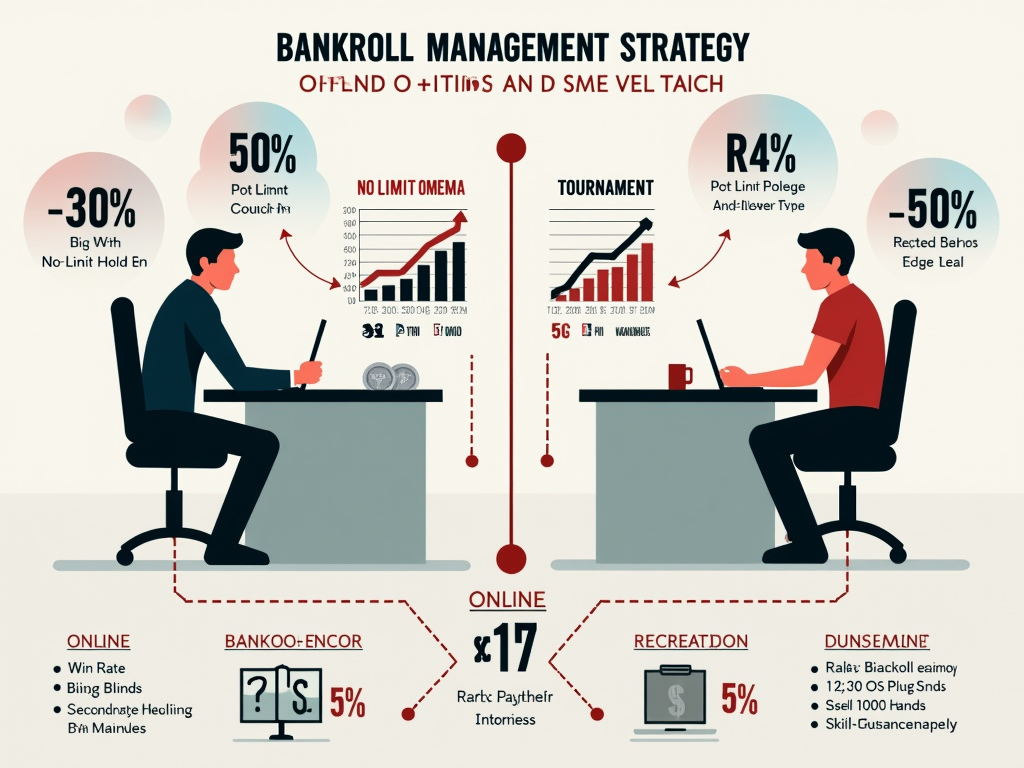Proper Bankroll Management for Poker Success
Proper bankroll management forms the foundation of poker success by protecting and growing poker funds while keeping them separate from personal finances. A well-managed bankroll provides financial security and mental stability, enabling clear decisions during the natural ups and downs of poker.
Key Takeaways
- Never risk more than 5% of your total bankroll in a single session and maintain at least 20 buy-ins for your chosen stake level
- Different poker formats require varying bankroll sizes – cash games need 20-50 buy-ins while tournaments demand 100-300+ buy-ins
- Professional players should maintain larger bankrolls (50+ buy-ins) compared to recreational players (20-30 buy-ins)
- Move up in stakes only when you have 30 full buy-ins for the next level, and move down if falling below 25 buy-ins
- Track each session carefully, including financial results, game conditions, and mental state to make data-driven decisions
The Importance of Discipline in Bankroll Management
I maintain strict bankroll guidelines to prevent emotional decisions during downswings. This disciplined approach serves as a safety net, protecting my poker capital from significant losses while maximizing potential gains.
Separating Poker Funds from Life Expenses
By separating poker funds from personal finances, I create clear boundaries that prevent mixing gambling money with essential living expenses. This separation allows focused play without worrying about paying bills or other financial obligations.
Bankroll Size Based on Game Type and Experience
The amount needed varies based on game type and skill level. Cash games require smaller reserves than tournaments due to lower variance. Professional players need deeper bankrolls to handle extended downswings and maintain consistent play at their chosen stakes.
Record Keeping and Self-Analysis
Regular tracking and analysis of results help identify leaks and adjust strategies accordingly. I record key metrics after each session: profits/losses, playing conditions, emotional state, and notable hands. This data guides future decisions about stake selection and game choice.
The Essential Rules of Poker Bankroll Management
Setting Up Your Poker Bankroll
I’ve learned that successful poker players treat their bankroll like professional traders handle investment capital – it’s money strictly set aside for playing poker. Your poker bankroll should be completely separate from your daily living expenses, bills, or emergency funds. Just like a day trader wouldn’t risk their rent money on stocks, you shouldn’t play poker with funds you can’t afford to lose.
Understanding Risk and Stake Selection
A solid poker strategy starts with smart bankroll management. I recommend following these key guidelines for managing your poker funds:
- Never risk more than 5% of your total bankroll in a single session
- Keep buy-ins between 2-5% of your total bankroll
- Maintain at least 20 buy-ins for your chosen stake level
- Move down in stakes if your bankroll drops below these thresholds
For example, if you’ve got a $1,000 bankroll, jumping into a $500 buy-in game would be a major mistake. Instead, you should look for games with $20–50 buy-ins to protect yourself from variance. Think of it like a financial buffer – you’re giving yourself room to handle the natural ups and downs of poker without risking your entire bankroll.
I’ve found that proper bankroll management techniques share similarities with other casino games. Much like in baccarat bankroll control, the key is maintaining strict discipline with your funds.
Segregating your poker bankroll isn’t just about organization – it’s about creating a psychological barrier that helps you make rational decisions at the table. By treating your poker funds as a dedicated tool for the game, you’ll find it easier to:
- Stay emotionally detached from individual session results
- Make decisions based on math rather than emotion
- Track your progress accurately over time
- Scale your stakes appropriately as your bankroll grows or shrinks
Remember, variance is a natural part of poker, and even the best players experience losing streaks. By following these bankroll management rules, you’ll give yourself the best chance to weather those downswings and stay in the game long enough to let your skill edge shine through.
Why Your Poker Career Depends on Proper Bankroll Management
Understanding Risk of Ruin
I’ve seen countless skilled poker players crash and burn – not because they played badly, but because they failed at managing their bankroll. Here’s the shocking truth: being good at poker isn’t enough to succeed. Even players winning 60% of their sessions can face devastating losses due to variance.
Let me break down the numbers that make proper bankroll management crucial. Playing with just 5 buy-ins puts you at a scary 30% risk of going broke. But when you increase that to 50 buy-ins, your risk drops dramatically to less than 1%. That’s why I always recommend mastering proper bankroll strategies before conquering poker tables.
Emotional Control and Peak Performance
Smart bankroll management isn’t just about protecting your money – it’s about protecting your mind. Having adequate funds helps you:
- Stay calm during inevitable downswings
- Make decisions based on strategy rather than fear
- Maintain emotional stability during losing streaks
- Keep playing your optimal game even when variance hits
- Avoid tilt-induced mistakes that compound losses
Think of your bankroll as armor that shields you from poker’s emotional swings. Without it, you’re vulnerable to tilt and stress that can destroy your A-game. I’ve found that players who maintain strict bankroll discipline consistently perform better under pressure.
When you’re properly rolled for your stakes, you can focus purely on making the best decisions. No more worrying about whether you can afford another buy-in or if this downswing will break you. Instead, you’ll play with confidence, knowing you’ve got the financial cushion to weather any storm.
The math is clear – poor bankroll management is the number one reason why good players go broke. By sticking to proven bankroll guidelines, you’ll dramatically increase your chances of long-term success. Remember, it’s not just about how well you play the cards – it’s about having the staying power to keep playing through the ups and downs of variance.
Required Buy-ins for Different Poker Formats
Format-Specific Bankroll Requirements
Let me break down the essential buy-in requirements for different poker formats to help you maintain a healthy bankroll. These guidelines will keep you playing comfortably within your limits while mastering poker strategy and gameplay.
Cash games in No-Limit Hold’em (NLHE) need a substantial cushion to handle normal variance. I recommend having 20-50 buy-ins ready. For example, if you’re playing $1/2 tables, your bankroll should range from $4,000 to $10,000. This gives you enough padding to weather downswings while playing your best game.
Pot-Limit Omaha (PLO) cash games demand even more protection — you’ll want 40-50+ buy-ins minimum. The larger swings in PLO mean you need extra buffer compared to NLHE. The increased variance comes from bigger pots and more complex hand combinations.
For tournament players, Multi-Table Tournaments (MTTs) require the largest bankroll relative to buy-in size. Here’s what you need for different tournament types:
- MTTs: 100-300+ buy-ins ($1,000-$3,000 for $10 tournaments)
- Sit-and-Gos (SNGs): 50-100+ buy-ins ($500-$1,000 for $10 games)
- Average Buy-In (ABI) should be carefully tracked to maintain proper bankroll levels
These requirements might seem high, but they’re crucial for managing your bankroll effectively and staying in action during inevitable downswings. I’ve found that players who follow these guidelines can focus better on their game instead of worrying about going broke.
The key is matching your bankroll to your preferred format while maintaining strict discipline. If your funds don’t meet these minimums, I suggest dropping down in stakes until they do. This approach to smart bankroll control helps ensure long-term success at the tables.
Remember, these numbers represent minimum requirements — having more is always better. Professional players often maintain even larger bankrolls relative to their regular stakes, giving them additional security and mental comfort during extended sessions.
Customizing Your Bankroll Requirements
Understanding How Skill Level Shapes Your Bankroll
Your poker win rate directly affects how much bankroll you’ll need to stay in action. I’ve found that players who consistently win at higher rates can take more aggressive approaches with their bankroll management. For example, if you’re winning at 5 big blinds per 100 hands (bb/100), you can likely play with a smaller bankroll than someone winning at 2 bb/100. If you’re interested in getting better at winning consistently, check out my guide on mastering poker strategy for both online and live play.
Game selection plays a crucial role in your bankroll needs. Pot-Limit Omaha (PLO) and turbo tournaments pack more variance than standard No-Limit Hold’em cash games. I recommend PLO players maintain a bankroll 1.5 to 2 times larger than what they’d need for equivalent stakes in Hold’em.
Professional vs Recreational Considerations
Professional players need stricter bankroll management than recreational players. When poker is your primary income source, you’ll want to maintain a more conservative approach. I suggest professionals keep at least 50 buy-ins for cash games, while recreational players might be comfortable with 20-30 buy-ins.
Here are key factors that influence your personal bankroll requirements:
- Your typical ROI (Return on Investment) in tournaments
- The rake structure in your regular games
- Your comfort level with variance
- Whether you have other income sources
- The stakes you’re playing relative to your total bankroll
- Your skill edge over the competition
The rake impact on bankroll requirements can’t be overlooked. Higher rake environments cut into your win rate, requiring a larger bankroll to withstand downswings. If you’re playing in a game with 5% rake versus one with 3% rake, I recommend adding an extra 10-15 buy-ins to your bankroll requirements.
For tournament players, the variance is naturally higher than in cash games. If you’re playing multi-table tournaments regularly, I suggest maintaining a minimum of 100 buy-ins for your average tournament buy-in amount. This approach is similar to what you might use when managing your bankroll at the blackjack table, where consistent betting patterns help control variance.
The skill edge you hold over your competition also affects your bankroll needs. A smaller edge means you’ll need a larger bankroll to handle the increased variance. I’ve seen many skilled players go broke by playing too high for their bankroll, even with a clear edge in their games.
For those transitioning between stakes or game types, like moving from Hold’em to Baccarat, you might find helpful parallels in my guide about smart bankroll control in baccarat. The principles of risk management translate well across different games.
Remember, these recommendations aren’t set in stone. Your personal circumstances, risk tolerance, and financial goals should guide your final decisions. By staying aware of these factors and adjusting your bankroll requirements accordingly, you’ll be better positioned to handle the natural ups and downs of poker while protecting your money.

Moving Through Stakes Successfully
Clear guidelines for moving between stakes can make or break your long-term poker success and profitability. I’ve found that having strict rules prevents emotional decisions that can damage your bankroll.
Rules for Moving Up and Down
Before moving up in stakes, I recommend having the full recommended bankroll — typically 30 buy-ins for your target level. For instance, if you’re planning to play $1/2 No-Limit Hold’em with $200 buy-ins, you’ll need a $6,000 bankroll. This cushion helps protect against variance and downswings.
Here are the key guidelines I follow for stake transitions:
- Move up only when you have 30 full buy-ins for the next stake level
- Drop down if your bankroll falls below 25 buy-ins for your current stake
- Take shots at higher stakes with no more than 3–5 buy-ins
- Set a strict stop-loss when shot taking – usually 2–3 buy-ins maximum
- Return to your regular stakes immediately if you hit your stop-loss
Shot taking can be an excellent way to test the waters at higher stakes, but it requires iron discipline. I suggest allocating a small portion of your roll – typically 3–5 buy-ins – specifically for these attempts. For example, if you’re playing $0.50/$1 with a $3,000 bankroll, you might use $600 to take a shot at $1/2.
Smart bankroll management strategies mean moving down in stakes when necessary. If your bankroll drops below 25 buy-ins for your current level, it’s time to step down. This isn’t a failure – it’s strategic preservation of your capital that lets you rebuild your bankroll from a safer position.
One crucial aspect of shot taking is having a predetermined stop-loss. Don’t wait until you’re emotionally tilted or your bankroll is critically damaged. If you lose 2–3 buy-ins at the higher stake, return to your regular games. This disciplined approach to bankroll control helps ensure you’ll have another opportunity to take shots in the future.
Remember that moving up in stakes isn’t just about having the right amount of money — your skill level needs to match the competition. I suggest spending time studying the game and analyzing your performance at your current stake before making the jump to ensure you’re truly ready for the challenge.
Track Everything or Fail
I can’t stress enough how tracking your poker sessions forms the backbone of successful bankroll management. Just like professional poker players master their game through detailed analysis, your path to success starts with comprehensive record-keeping.
Essential Tracking Components
Your tracking system needs to capture every crucial detail of your sessions. Here are the key elements I recommend documenting for each poker session:
- Date and time of play
- Game type (Cash, Tournament, Sit & Go)
- Stakes and buy-in amounts
- Session duration
- Final results (profit/loss)
- Notable hands or situations
- Mental state and fatigue level
- Playing conditions (online/live venue)
Digital Tools for Success
Modern poker tracking software has transformed how players monitor their performance. PokerTracker 4 and Hold’em Manager 3 stand out as industry leaders, automatically collecting data while you play online. These tools calculate essential metrics like big blinds per 100 hands (bb/100) and return on investment (ROI).
For players who prefer simpler solutions, the Poker Bankroll Tracker app offers a user-friendly interface for manual entry. I’ve found that even a basic spreadsheet can work effectively if you’re consistent with your record-keeping.
The real power of tracking comes from analyzing trends in your play. By reviewing your documented sessions, you’ll spot leaks in your game, identify your most profitable games, and make data-driven decisions about managing your bankroll effectively.
Pay special attention to your hourly rate and ROI across different stakes and formats. This information helps you decide when to move up or down in stakes, matching your bankroll management strategy with your skill level.
Remember to include notes about your mental state and playing conditions — these factors often impact performance significantly. I’ve noticed that players who track these softer metrics alongside their financial results develop a more complete understanding of their poker journey.
By maintaining detailed records, you’ll transform random poker sessions into a structured approach to improvement. This data becomes your roadmap for making informed decisions about game selection, stake levels, and optimal playing times.

Sources:
Upswing Poker: Article – Bankroll Management Strategy Tips Used by the Pros
PokerNews: Article – Poker Bankroll Management: A Comprehensive Guide
Jonathan Little Poker: Article – The Ultimate Poker Bankroll Management Guide
CardPlayer Lifestyle: Article – Poker Bankroll Management 101





